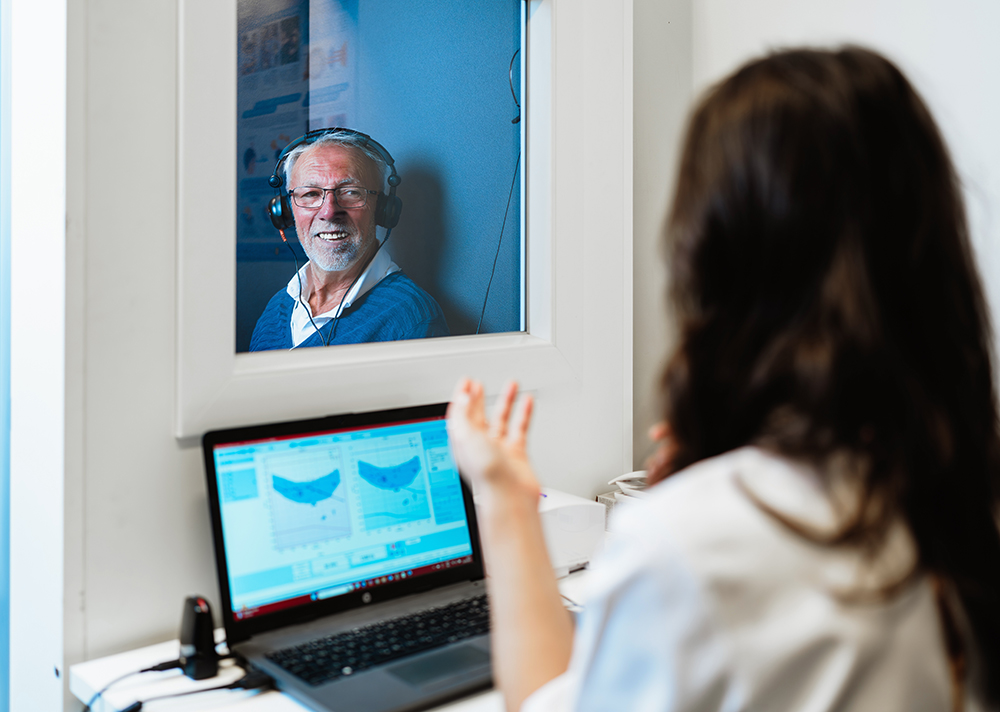The Role of Hearing Tests in Preventative Health Care
Hearing tests are an important part of preventative health care, yet many
New Location Now Open in Fort Mitchell! LEARN MORE →

By: Vanessa Ewert, Au.D, LIC.-A | February 28, 2024
Hearing loss can present its own set of unique challenges, often leading to feelings of isolation or frustration when communication becomes difficult. But there’s a light at the end of the tunnel – hearing aids. These compact yet powerful devices, tailored to meet individual needs, can significantly improve your quality of life by enhancing sound clarity and volume. Getting a hearing aid involves several steps, including fitting – a crucial stage that ensures the best performance and comfort for you. This comprehensive guide on hearing aid fitting aims to clarify this important stage in your journey towards improved hearing health. Armed with the right information, you can dispel any worries and set yourself on the path to richer auditory experiences.
Before your hearing aid fitting appointment, it’s essential to take a few preparatory steps to ensure a successful experience and maximize the benefits of your new device. Start by gaining a basic understanding of hearing aids, including how they function and what outcomes to anticipate. Consider exploring the various types and styles of hearing aids available, each offering distinct features and advantages tailored to different preferences and needs.
Audiograms play a significant role in tailoring your hearing aid to fit perfectly. This graph, which maps out your hearing capabilities across different frequencies, provides vital data that allows the audiologist to adjust your device precisely. Understanding the information on your audiogram can also be beneficial when discussing any potential changes in your hearing over time with your specialist. Additionally, audiograms serve as a visual representation of your hearing health, offering valuable insights into the degree and nature of your hearing loss. This information enables the audiologist to devise a comprehensive treatment plan tailored to your specific needs and preferences.
A well-fitted hearing aid is more than just a device; it’s your key to improved communication and connection. A properly adjusted hearing aid can significantly reduce the effort of listening, making conversations less exhausting and more enjoyable. Additionally, a well-fitted device can help you detect sounds that were previously hard to hear, enhancing your overall auditory experience and quality of life.
Your first hearing aid fitting session is a significant moment in your path towards improved hearing. It’s a process that combines technology and personalization to provide you with the best possible hearing experience.
In this session, your audiologist will first adjust the device to match your specific hearing loss profile. This involves programming the aid based on your audiogram, which is a graph of your hearing ability. The next step is to place the device in your ear and make physical adjustments for optimal comfort and fit. Finally, they will guide you on how to use and maintain your new device, answering any questions you might have along the way.
This process offers several benefits; primarily, it ensures that the device works effectively for you by enhancing sounds according to your unique needs. Additionally, it provides an opportunity for you to learn about proper care and usage directly from an expert.
However, you might feel overwhelmed by all the new information or find adjusting to the device a bit challenging initially. But don’t worry – these feelings are temporary and with consistent use and follow-ups with your specialist, they’ll soon disappear as you start experiencing improved auditory capabilities.
Remember, your role doesn’t stop after getting fitted for a hearing aid. It’s an ongoing process that requires regular follow-ups and adjustments to ensure optimal performance. So, get ready to actively engage in this important step towards better hearing health!
Diving into real ear measurement, this process takes your hearing aid fitting to the next level. This technique ensures precise sound delivery, confirming that your hearing aids are working optimally in your ears. The benefits are twofold: not only does it confirm that the device is amplifying sounds to match your specific hearing loss profile, but it also gives you peace of mind knowing that you’re getting the most out of your investment in better hearing health.
Personalizing your auditory experience is not a one-time task, but an ongoing process. Just as your life and environment change over time, so too should the settings of your hearing aid. Fine-tuning and adjustments are vital to ensuring that your device continues to meet your unique hearing needs. Regular follow-ups with your audiologist can help make this personalization process smoother, ultimately leading to a more enjoyable and fulfilling auditory experience.
It’s important to remember that adjusting to hearing aids is a gradual process, unlike the immediate correction provided by vision glasses. For many, there’s a significant gap between suspecting hearing loss and seeking treatment, during which the brain may become unaccustomed to certain tones and pitches. Even the sound of one’s own voice can initially feel jarring.
To ease the adjustment period, consider wearing the aids primarily at home initially. This controlled environment allows for focusing on one-on-one conversations and minimizing background noise. Informing household members about your new aids and preferred communication methods can further enhance the adjustment process.
Additionally, incorporating daily exercises into your routine can help sharpen essential auditory skills. Practice identifying the source of sounds around you and distinguishing between different sounds, particularly in noisy environments. These exercises contribute to honing localization abilities and improving alertness while navigating various settings. Lastly, it’s essential to give yourself breaks during the adjustment phase. Gradually increase the duration of wear over time, allowing your brain to acclimate to the newfound auditory stimulation at a manageable pace. With patience and perseverance, the transition to wearing hearing aids can become smoother and more rewarding.
Have you ever wondered how important regular check-ups and continuous adjustments are in your hearing health journey? Regular visits to your audiologist play a crucial role in maintaining optimal performance of your hearing aids. Over time, changes in your hearing abilities or lifestyle may require adjustments to the settings of your device. These tweaks ensure that you continue to enjoy clear and comfortable sound quality, tailored to your unique needs.
Additionally, these check-ups also provide an opportunity for professional cleaning of your device and addressing any concerns or issues you might be facing. So, keep up with those appointments – they’re key to ensuring that you’re making the most out of your investment in better hearing health!
Now that you have your new hearing aids, it’s important to learn how to care for them properly. This will not only extend the life of your device but also ensure its optimal performance. Here are some simple yet effective maintenance and care tips.
First, cleaning your hearing aids regularly is important. It helps prevent earwax buildup which can impact the sound quality of your device. Use a soft, dry cloth to clean the surface and a small brush (often provided with the device) to remove any wax from the openings.
Second, storing your hearing aids in a safe and dry place when not in use is important. This protects them from damage due to moisture or accidental falls. Most devices come with a storage case for this purpose.
Lastly, remember that batteries need regular replacement or recharging, depending on the type of hearing aid you have. Always keep some spare batteries on hand or ensure you charge your device overnight for uninterrupted use during the day.
By taking good care of your new hearing aids, you can significantly enhance their performance and longevity. So go ahead and take control of your auditory health with these simple yet effective maintenance tips!
As you’ve discovered, hearing aid fitting is a vital step in your journey to better hearing health. It’s a process that combines personalization and technology to ensure the device works effectively for you. But this is just the beginning. Regular follow-ups and adjustments are necessary to maintain optimal performance of your hearing aids as your life and environment change over time.
At Bluegrass Hearing Clinic, we’re here to guide you through every step of this process. Whether it’s your first fitting or routine check-up, our team of dedicated audiologists are ready to assist at any one of our multiple locations, including: Bardstown, Danville, Elizabethtown, Frankfort, Lexington, Mount Sterling, Nicholasville, Paris, Richmond or Somerset, KY offices at: (859) 295-5729.
Your improved auditory experiences await! Feel free to reach out today for more information or schedule an appointment with us. We look forward to helping you unlock the full potential of your hearing aids.
Tags: hearing aid basics, hearing aid fitting, how-to guides

Hearing tests are an important part of preventative health care, yet many
By: Vanessa Ewert, Au.D, LIC.-A | November 18, 2025

Living with tinnitus means dealing with sounds that only you can hear,
By: Vanessa Ewert, Au.D, LIC.-A | October 3, 2025

When you’re getting your hearing tested, you might be surprised by
By: Vanessa Ewert, Au.D, LIC.-A | September 24, 2025
